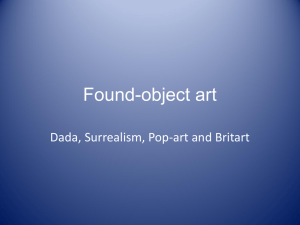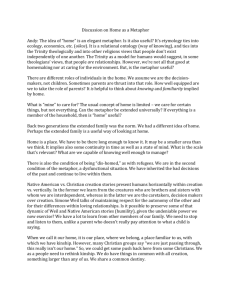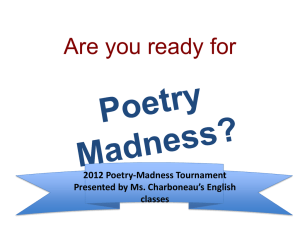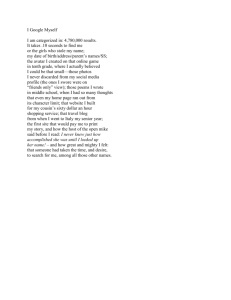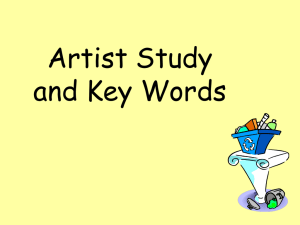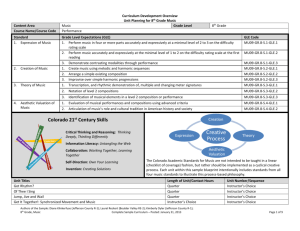Bottle Caps to Old Shoes Instructional Unit
advertisement
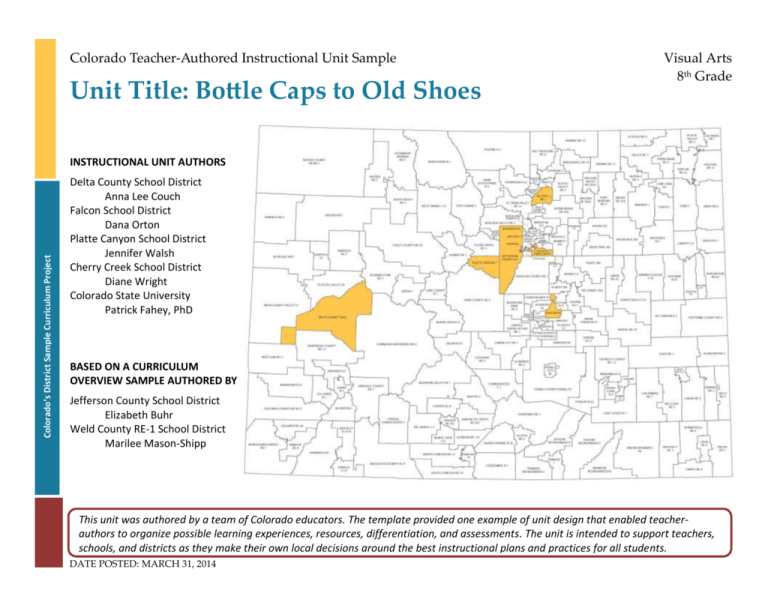
Colorado Teacher-Authored Instructional Unit Sample Unit Title: Bottle Caps to Old Shoes Visual Arts 8th Grade Colorado’s District Sample Curriculum Project INSTRUCTIONAL UNIT AUTHORS Delta County School District Anna Lee Couch Falcon School District Dana Orton Platte Canyon School District Jennifer Walsh Cherry Creek School District Diane Wright Colorado State University Patrick Fahey, PhD BASED ON A CURRICULUM OVERVIEW SAMPLE AUTHORED BY Jefferson County School District Elizabeth Buhr Weld County RE-1 School District Marilee Mason-Shipp This unit was authored by a team of Colorado educators. The template provided one example of unit design that enabled teacherauthors to organize possible learning experiences, resources, differentiation, and assessments. The unit is intended to support teachers, schools, and districts as they make their own local decisions around the best instructional plans and practices for all students. DATE POSTED: MARCH 31, 2014 Colorado Teacher-Authored Sample Instructional Unit Content Area Visual Arts 8th Grade Grade Level Course Name/Course Code Standard Grade Level Expectations (GLE) GLE Code 1. 1. Conceptual art theories explain how works of art are created VA09-GR.8-S.1-GLE.1 2. The history of art, world cultures, and artistic styles influence contemporary art concerns VA09-GR.8-S.1-GLE.2 3. Art criticism strategies are used to analyze, interpret, and make informed judgments about works of art VA09-GR.8-S.1-GLE.3 Envision and Critique to Reflect 1. Visual literacy skills help to establish personal meaning and artistic intent in works of art VA09-GR.8-S.2-GLE.1 2. Key concepts, issues, and themes in the visual arts can solve problems using real-world applications VA09-GR.8-S.2-GLE.2 Invent and Discover to Create 1. Achieve artistic purpose to communicate intent VA09-GR.8-S.3-GLE.1 2. Demonstrate technical proficiency and craftsmanship when planning VA09-GR.8-S.3-GLE.2 3. Utilize current and available technology to refine an idea, and create original and imaginative works of art VA09-GR.8-S.3-GLE.3 1. Visual arts are valuable for a variety of art and non-art related lifelong endeavors VA09-GR.8-S.4-GLE.1 2. Cultural traditions and events impact visual arts within a community VA09-GR.8-S.4-GLE.2 3. Visual arts provide an opportunity to explore sustainable environments, design and architecture VA09-GR.8-S.4-GLE.3 2. 3. 4. Observe and Learn to Comprehend Relate and Connect to Transfer Colorado 21st Century Skills Comprehend Critical Thinking and Reasoning: Thinking Deeply, Thinking Differently Invention Transfer Creative Process Reflect Information Literacy: Untangling the Web Collaboration: Working Together, Learning Together Self-Direction: Own Your Learning Invention: Creating Solutions Create The Colorado Academic Standards for Visual Arts are not intended to be taught in a linear (checklist of coverage) fashion, but rather should be implemented as a cyclical creative process. Each unit within this sample blueprint intentionally includes standards from all four visual arts standards to illustrate this process-based philosophy. Unit Titles Length of Unit/Contact Hours Unit Number/Sequence Bottle Caps to Old Shoes Instructor Choice Instructor Choice 8th Grade, Visual Arts Unit Title: Bottle Caps to Old Shoes Page 1 of 14 Colorado Teacher-Authored Sample Instructional Unit Unit Title Bottle Caps to Old Shoes Focusing Lens(es) Change/Transition Inquiry Questions (EngagingDebatable): Unit Strands Comprehend /Reflect/Create/Transfer Concepts Investigate/ Discover, Culture, Patterns, Texture, Movement, Composition, Found objects, Expressive Features and Characteristics of Art, Metaphor/Personal Meaning, Material Length of Unit Standards and Grade Level Expectations Addressed in this Unit Instructor Choice VA09-GR.8-S.1-GLE.1, VA09-GR.8-S.1-GLE.2, VA09-GR.8-S.1-GLE.3 VA09-GR.8-S.2-GLE.1, VA09-GR.8-S.2-GLE.2 VA09-GR.8-S.3-GLE.1, VA09-GR.8-S.3-GLE.2, VA09-GR.8-S.3-GLE.3 VA09-GR.8-S.4-GLE.1, VA09-GR.8-S.4-GLE.2, VA09-GR.8-S.4-GLE.3 What would motivate an artist to consider using discarded object and materials in their art work? (VA09-GR.8-S.1-GLE.1,2,3) and ( VA09-GR.8-S.2GLE.1,2) and ( VA09-GR.8-S.4-GLE.1, 2,3) When does putting junk together become art? What is the difference between little ‘a’ art and big ‘A’ Art? Why should we value art made from discarded objects and materials? Generalizations My students will Understand that… Guiding Questions Factual Conceptual Compositions in any media are planned and thoughtfully constructed with deliberate and thoughtful evaluation of the expressive features and characteristics of art. (VA09GR.8-S.1-GLE.1,2,3) and (VA09-GR.8-S.2-GLE.1,2) and (VA09-GR.8-S.3-GLE.1,2,3) and (VA09-GR.8-S.4-GLE.1,2,3) What Principles of Design and Elements of Art might an artist use in assembling compositions in any media? What does it mean to be deliberate in art making? Artist throughout history, world cultures and contemporary life intentionally use discarded and/or recycled objects and materials to create meaningful art. (VA09-GR.8-S.1-GLE.1,2,3) and (VA09-GR.8-S.2-GLE.1,2) and ( VA09-GR.8-S.3-GLE.1,2,3) and (VA09-GR.8-S.4GLE.1,2,3) What are the ways artists can assemble objects? What does an artist value if s/he uses discarded and/or recycled objects and materials in their art? The intentional use of discarded and/or recycled objects and materials (found objects) reveal the environment or culture of the artist. (VA09-GR.8-S.1-GLE.1,2,3) and (VA09-GR.8-S.2-GLE.1,2) and ( VA09-GR.8-S.3-GLE.1,2,3) and (VA09-GR.8-S.4-GLE.1,2,3) What expressive features might be employed to discarded and/or recycled objects and materials that reveal the culture or environment of the artist? In what ways is environment or culture of the artist revealed in the artwork? 8th Grade, Visual Arts Unit Title: Bottle Caps to Old Shoes Page 2 of 14 Colorado Teacher-Authored Sample Instructional Unit Artists use non-art materials (found objects, recycled, discarded materials) to construct metaphor-based artworks that communicate personal meaning. (VA09GR.8-S.1-GLE.1,2,3) and (VA09-GR.8-S.2-GLE.1,2) and (VA09-GR.8-S.3-GLE.1,2,3) and (VA09-GR.8-S.4-GLE.1,2,3) What do the sculptures of Zac Freeman and Michele Stitzlein tell you about these artists? How do you know that? What does it mean to organize discarded objects and materials with intention? Artists employ craftsmanship to give new meaning to discarded and/or recycled objects (found objects) and materials for visual meaning. (VA09-GR.8-S.1-GLE.1,2,3) and (VA09-GR.8-S.2-GLE.1,2) and (VA09-GR.8-S.3GLE.1,2,3) and (VA09-GR.8-S.4-GLE.1,2,3) What does it mean to assign new meaning to an object? How do Choi Jeong-Hwas and Jud Turner attempt this in their work? Why does craftsmanship matter? Critical Content: Key Skills: My students will Know… My students will be able to (Do)… Steps to assembling compositions in any media using Principles of Design and Elements of Art. (VA09-GR.8-S.1-GLE.1,2,3) and (VA09-GR.8-S.2-GLE.1,2) and (VA09-GR.8-S.3-GLE.1,2,3) and (VA09-GR.8-S.4-GLE.1,2,3) Ways to identify artists that intentionally use discarded and/or recycled objects and materials (found objects) to create meaningful art; such as: Leo Sewell who creates found object animal sculptures; Stuart Haygarth who combines light and found objects; Haroshi, Japanese artist, salvages skateboards to create sculptures; and Tadashi Kawamata who creates large scale sculptures with zip ties. (VA09GR.8-S.1-GLE.1,2,3) and (VA09-GR.8-S.2-GLE.1,2) and (VA09-GR.8-S.3-GLE.1,2,3) and (VA09-GR.8-S.4-GLE.1,2,3) Criteria that influence intent when artists use discarded and/or recycled objects and materials (VA09-GR.8-S.1-GLE.1,2,3)and (VA09-GR.8-S.3-GLE.1,2,3) and (VA09GR.8-S.4-GLE.1,2,3) Ways to elevate metaphor and personal meaning through the collection and organization of discarded and/or recycled objects and materials (found objects) such as in the work of Alain Bellino, Karen Hatzieorgiou and Martin Sanchez. (VA09-GR.8-S.2-GLE.1,2) and (VA09-GR.8-S.3-GLE.1,2,3) and (VA09-GR.8-S.4GLE.1,2,3) The importance of craftsmanshipo (VA09-GR.8-S.1-GLE.1,2,3) and (VA09-GR.8-S.2GLE.1,2) and (VA09-GR.8-S.3-GLE.1,2,3) and (VA09-GR.8-S.4-GLE.1,2,3) 8th Grade, Visual Arts Assemble compositions in any media using Principles of Design and Elements of Art. (VA09-GR.8-S.1-GLE.1,2,3) and (VA09-GR.8-S.2-GLE.1,2) and (VA09-GR.8-S.3GLE.1,2,3) and (VA09-GR.8-S.4-GLE.1,2,3) Identify artists throughout history, world cultures and contemporary life that intentionally use discarded and/or recycled objects and materials to create meaningful art. (VA09-GR.8-S.1-GLE.1,2,3) and (VA09-GR.8-S.2-GLE.1,2) and (VA09GR.8-S.3-GLE.1,2,3) and (VA09-GR.8-S.4-GLE.1,2,3) Describe and discuss how intent influences artists to reveal the environment or culture. (VA09-GR.8-S.1-GLE.1,2,3) and (VA09-GR.8-S.2-GLE.1,2) and (VA09-GR.8S.3-GLE.1,2,3) and (VA09-GR.8-S.4-GLE.1,2,3) Evidence the use of metaphor and personal meaning through the collection and organization of discarded and/or recycled objects and materials. (VA09-GR.8-S.1GLE.1,2,3) and (VA09-GR.8-S.2-GLE.1,2) and (VA09-GR.8-S.3-GLE.1,2,3) and (VA09GR.8-S.4-GLE.1,2,3) Employ craftsmanship to enhance the creation of art. (VA09-GR.8-S.1-GLE.1,2,3) and (VA09-GR.8-S.2-GLE.1,2) and (VA09-GR.8-S.3-GLE.1,2,3) and (VA09-GR.8-S.4GLE.1,2,3) Unit Title: Bottle Caps to Old Shoes Page 3 of 14 Colorado Teacher-Authored Sample Instructional Unit Critical Language: includes the Academic and Technical vocabulary, semantics, and discourse which are particular to and necessary for accessing a given discipline. EXAMPLE: A student in Language Arts can demonstrate the ability to apply and comprehend critical language through the following statement: “Mark Twain exposes the hypocrisy of slavery through the use of satire.” A student in ______________ can demonstrate the ability to apply and comprehend critical language through the following statement(s): Artists create art by transforming discarded/recycled objects, giving them new meaning and insight into artistic intent. Academic Vocabulary: Sustainability, change/transition, innovation, investigate/discover, culture, composition, intent, craftsmanship , inspiration, assembling, metaphor Technical Vocabulary: Patterns, texture, aesthetics, movement, decontextualizing, elevate, personal meaning or voice 8th Grade, Visual Arts Unit Title: Bottle Caps to Old Shoes Page 4 of 14 Unit Description: Considerations: Colorado Teacher-Authored Sample Instructional Unit In this unit students will explore written and visual metaphor used by artists to create meaning in works of art. Examining a variety of assemblage and found object three-dimensional artists, students will transform and manipulate discarded materials and found objects to communicate a specific idea/concept for an audience. The unit asks students to make connections between linguistic transformations (e.g., the creation of metaphor, analogy, slang, colloquialisms, etc) that assign/represent new meanings for words or phrases to the way in which some artists use objects (ordinary, found, discarded) in new and unique ways. The unit culminates in a performance assessment that asks students to transform every-day and/or discarded (school/classroom) items into an art work that assigns new meanings to these materials. The two primary goals of this unit are that students understand that all materials are inherently “transformed” or given new meaning when used in a work of art and that ideation and planning are essential for creating successful works of art. This unit will depend on students’ ability to access and reuse materials in their environment. This may prove difficult for some students, so teachers may wish to start establishing a stockpile of objects for students to use during this unit. Discarded and every-day objects used within the school/classroom environments provide a logical place to begin creating such an inventory. Indeed, the performance assessment lends itself nicely to the use of such materials. Unit Generalizations Key Generalization: Artists use non-art materials (found objects, recycled, discarded materials) to construct metaphor-based artworks that communicate personal meaning Compositions in any media are planned and thoughtfully constructed with deliberate and thoughtful evaluation of the expressive features and characteristics of art Supporting Generalizations: Artist throughout history, world cultures and contemporary life intentionally use discarded and/or recycled objects and materials to create meaningful art The intentional use of discarded and/or recycled objects and materials (found objects) reveal the environment or culture of the artist Artists employ craftsmanship to give new meaning to discarded and/or recycled objects (found objects) and materials for visual meaning Performance Assessment: The capstone/summative assessment for this unit. Claims: (Key generalization(s) to be mastered and demonstrated through the capstone assessment.) Stimulus Material: (Engaging scenario that includes role, audience, goal/outcome and explicitly connects the key generalization) Product/Evidence: (Expected product from students) 8th Grade, Visual Arts Artists use non-art materials (found objects, recycled, discarded materials) to construct metaphor-based artworks that communicate personal meaning The principal of this school is very interested in helping students recognize and not take for granted the materials and items used within the school environment. The principal has asked your class to take the discarded and/or ordinary objects and materials and use them in ways that gives them unique meanings; ways that help the students see and contemplate these materials/objects anew. You decide to collect discarded items within the school environment that you find over a three-week time span. Your goal is to create a sculpture that gives new meaning to these materials; you want the viewer to forget the original purpose/use of the items used to create your art work. To evaluate the extent to which you have achieved this goal, you will ask your fellow students to offer titles (anonymously) to the sculpture you create when you present the work to the school. Students will each create a three-dimensional art work using discarded and found objects; transforming the materials to create a visual metaphor that represents the intended idea/concept of the artist. Students will also create a formal plan to map out the creation of their sculpture, outlining the process and products they will utilize and describe the intentions behind the choice, use, and reuse of objects. Unit Title: Bottle Caps to Old Shoes Page 5 of 14 Colorado Teacher-Authored Sample Instructional Unit Differentiation: (Multiple modes for student expression) Students may complete the requirements of the performance assessment in number of ways, including Working with partners or in small groups to create the sculpture Working in small groups to create the sculpture Dictating (orally) the process/conceptual map Creating a video representation of the process/concept map (e.g., using Voicethread or other free software https://www.google.com/#q=voicethread ) Texts for independent reading or for class read aloud to support the content Informational/Non-Fiction Fiction Found Object Art - Dorothy Spencer Found Object Art - Tina Skinner Secrets of Rusty Things: Transforming Found objects into art - Michael de Meng Raw + Material=Art: Found, scavenged and upcycled - Tristan Manco Recycled Re-Seen: Folk art from the global scrap heap - Charlene Cerny Duchamp (Basic Art) - Janis Mink Man Ray - Guido Comis Ongoing Discipline-Specific Learning Experiences 1. 2. Description: Think/work like an artist- Apply the expressive features and characteristics using multiple media (found objects, discarded materials) , techniques and process to express original ideas Teacher Resources: Making Art: Form and Meaning - T. Barrett Talking About Student Art - T. Barrett Studio Thinking 2: The real benefits of visual arts education - L. Hetland, E. Winner, S. Veenema, and K Sheridan Student Resources: Sketchbooks, journals, process planning and art works, completed art work and critiques Skills: Analyze and synthesize ideas, as well as knowledge of materials and process, to conceptualize about and create plans and art works Assessment: Throughout the unit students will use journaling and sketchbooks to critique and evaluate the creative process utilized in all art making. Description: Think/work like an artist using symbols; effectively applying them to assemblage Teacher Resources: Making Art: Form and Meaning - T. Barrett Talking About Student Art - T. Barrett Studio Thinking 2: The real benefits of visual arts education - L. Hetland, E. Winner, S. Veenema, and K Sheridan Student Resources: Sketchbooks, journal, process planning and art works, completed art work and critiques 8th Grade, Visual Arts Unit Title: Bottle Caps to Old Shoes Page 6 of 14 Colorado Teacher-Authored Sample Instructional Unit Skills: Analyze and synthesize ideas, as well as knowledge of materials and process, to conceptualize about and create plans and art works. Assessment: Throughout the unit students will: Create art works using multiple media (found objects, discarded materials) , techniques and process to express original ideas Use journaling and sketchbooks to inform their decisions in making art Prior Knowledge and Experiences This unit presumes that students understand how to function responsibly and safely in an art studio environment, as well as how to use tools and materials properly. Throughout the duration of the unit, students will apply (and expand upon) previous knowledge of the significance and use the expressive features and characteristics of art. Likewise, the unit will develop students’ ability to intentionally plan for the creation of art works appropriate for this grade level and content. Teachers may wish to revisit conceptually mapping basics and their connection to the ideation and creative process. Learning Experience # 1 The teacher may bring in a list and/or images of commonly used metaphors so that students can identify how figurative language, specifically metaphors, can change the literal meaning of words. Generalization Connection(s): Compositions in any media are planned and thoughtfully constructed with deliberate and thoughtful evaluation of the expressive features and characteristics of art Teacher Resources: http://www.buzzle.com/articles/metaphor-list.html (Metaphor ideas) http://grammar.about.com/od/tz/g/vismeterm.htm (Metaphor ideas) http://grammar.about.com/od/mo/g/metaphorterm.htm (Metaphor ideas) http://grammar.about.com/od/pq/g/parodyterm.htm (Metaphor ideas) https://www.google.com/search?q=found+art+images&tbm=isch&tbo=u&source=univ&sa=X&ei=4p8cU7KDGdOyqQHxpYDQCg&ved =0CCcQsAQ&biw=1045&bih=660 (Found art images) https://www.google.com/search?q=duchamp+images&tbm=isch&tbo=u&source=univ&sa=X&ei=VqEcU72JEOyFyQGniIC4Cw&ved=0 CCcQsAQ&biw=1045&bih=660 (Duchamp images) http://photobucket.com/images/found%20art?page=4 (Images of student-made found art) http://photobucket.com/images/duchamp?page=1 (Duchamp images) http://photobucket.com/images/man%20ray?page=1 (Man Ray images) http://smarthistory.khanacademy.org/surrealism-manray.html (Man Ray found art images) Student Resources: https://www.google.com/search?q=found+art+images&tbm=isch&tbo=u&source=univ&sa=X&ei=4p8cU7KDGdOyqQHxpYDQCg&ved =0CCcQsAQ&biw=1045&bih=660 (Found art images) http://www.youtube.com/watch?v=K9Wtx5-OjDs (You Tube video on found object sculpture) Assessment: Students will construct a journal/sketchbook entry describing how images and words can create metaphors. Sketchbooks and journals allow for demonstration through learning that elicits depth and complexity due to the organic nature of the format. Teachers may wish to provide students with a template (e.g., a word/semantic web template) for the entry. http://www.eduplace.com/graphicorganizer/pdf/cluster.pdf (Cluster/idea web) Students will also use image examples provided, and create a collage/visual representation of several chosen metaphor examples. 8th Grade, Visual Arts Unit Title: Bottle Caps to Old Shoes Page 7 of 14 Differentiation: (Multiple means for students to access content and multiple modes for student to express understanding.) Extensions for depth and complexity: Colorado Teacher-Authored Sample Instructional Unit Access (Resources and/or Process) Expression (Products and/or Performance) Students may work in small groups or pairs to develop list http://www.eduplace.com/graphicorganizer/pdf/cluster.pdf (Cluster/idea web) Students may describe the metaphor pairing rather than creating a collage Students may use a graphic organizer to document the ways in which images and language can create/represent metaphors Access (Resources and/or Process) Expression (Products and/or Performance) Students may research specific artists employing metaphor in their art work and the source material for their ideas/concepts Students may present research in a PowerPoint or video presentation Critical Content: Ways to elevate metaphor and personal meaning through the collection and organization of discarded and/or recycled objects and materials Metaphor gives new meaning to words and materials when these elements are combined in new and unique ways Key Skills: Identify, compare and contrast written and visual metaphor Critical Language: Metaphor, meaning, transform Learning Experience # 2 The teacher will provide students with images using visual metaphor for rhetorical purposes so that students compare and contrast how images elucidate meaning in metaphors. Generalization Connection(s): Compositions in any media are planned and thoughtfully constructed with deliberate and thoughtful evaluation of the expressive features and characteristics of art Teacher Resources: http://www.buzzle.com/articles/metaphor-list.html (Metaphor ideas) http://grammar.about.com/od/tz/g/vismeterm.htm (Metaphor ideas) http://grammar.about.com/od/mo/g/metaphorterm.htm (Metaphor ideas) http://grammar.about.com/od/pq/g/parodyterm.htm (Metaphor ideas) https://www.google.com/search?q=found+art+images&tbm=isch&tbo=u&source=univ&sa=X&ei=4p8cU7KDGdOyqQHxpYDQCg&ved =0CCcQsAQ&biw=1045&bih=660 (Found art images) https://www.google.com/search?q=duchamp+images&tbm=isch&tbo=u&source=univ&sa=X&ei=VqEcU72JEOyFyQGniIC4Cw&ved=0 CCcQsAQ&biw=1045&bih=660 (Duchamp images) http://photobucket.com/images/found%20art?page=4 (Images of student-made found art) http://photobucket.com/images/duchamp?page=1 (Duchamp images) http://photobucket.com/images/man%20ray?page=1 (Man Ray images) http://smarthistory.khanacademy.org/surrealism-manray.html (Man Ray found art images) Student Resources: https://www.google.com/search?q=found+art+images&tbm=isch&tbo=u&source=univ&sa=X&ei=4p8cU7KDGdOyqQHxpYDQCg&ved =0CCcQsAQ&biw=1045&bih=660 (Found art images) http://www.youtube.com/watch?v=K9Wtx5-OjDs (You Tube video on found object sculpture) http://www.eduplace.com/graphicorganizer/pdf/cluster.pdf (Cluster/idea web) 8th Grade, Visual Arts Unit Title: Bottle Caps to Old Shoes Page 8 of 14 Assessment: Colorado Teacher-Authored Sample Instructional Unit Students will choose one artist (see teacher resources) and one work of art to explain, in a journal/sketchbook entry, the use of visual metaphor. Sketchbooks and journals allow for demonstration through learning that elicits depth and complexity due to the organic nature of the format. Teachers may wish to provide students with a template (e.g., a T-chart template) for the entry. http://www.eduplace.com/graphicorganizer/pdf/tchart_eng.pdf (T-chart graphic organizer) Students will also create their own word pairings and sketches to illustrate the visual metaphor suggested by the pairings. Differentiation: (Multiple means for students to access content and multiple modes for student to express understanding.) Access (Resources and/or Process) Expression (Products and/or Performance) http://www.eduplace.com/graphicorganizer/pdf/tchart_eng.p df (T-chart graphic organizer) Students may work in pairs to create their sketches Students may use visual images to complete the journal entry (using the graphic organizer) Students may use provided images and arrange them to create visual metaphors Extensions for depth and complexity: Access (Resources and/or Process) Expression (Products and/or Performance) Students may research the use and role of rhetorical metaphor in advertising https://www.google.com/search?q=visual+metaphor+in+adve rtising&tbm=isch&tbo=u&source=univ&sa=X&ei=IaccU6O 3LMupqwGBjoCAAQ&sqi=2&ved=0CCcQsAQ&biw=1045& bih=660 (Visual metaphor advertising images) Students may create an advertisement or series of advertisements employing rhetorical metaphor to sell on item of their choice Critical Content: How artists consider where to get ideas for art work Ways to elevate metaphor and personal meaning through the collection and organization of discarded and/or recycled objects and materials Metaphor gives new meaning to words and materials when these elements are combined in new and unique ways Key Skills: Identify, compare and contrast written and visual metaphor Compare and contrast the unique organizational styles of artists Critical Language: Metaphor, meaning, transform Learning Experience # 3 The teacher may provide a variety of found objects so that students can brainstorm how physical objects/materials can be combined and presented in ways (like word pairs) to change their use/function and create new meaning/visual metaphors. Generalization Connection(s): Artists use non-art materials (found objects, recycled, discarded materials) to construct metaphor-based artworks that communicate personal meaning Compositions in any media are planned and thoughtfully constructed with deliberate and thoughtful evaluation of the expressive features and characteristics of art Artists employ craftsmanship to give new meaning to discarded and/or recycled objects (found objects) and materials for visual meaning Teacher Resources: http://www.cfa.arizona.edu/are477/files/lsnfnd.htm (Found object art- lesson ideas) http://www.incredibleart.org/files/ideas.htm (Where and how artists come up with ideas) http://www.n8w.com/wp/3242 (Ideas for generating ideas) 8th Grade, Visual Arts Unit Title: Bottle Caps to Old Shoes Page 9 of 14 Colorado Teacher-Authored Sample Instructional Unit http://www.oneonta.edu/faculty/sakoult/3d/assignments/found/ (Found object projects) https://www.google.com/search?q=found+art+images&tbm=isch&tbo=u&source=univ&sa=X&ei=4p8cU7KDGdOyqQHxpYDQCg&ved =0CCcQsAQ&biw=1045&bih=660 (Found art images) https://www.google.com/search?q=duchamp+images&tbm=isch&tbo=u&source=univ&sa=X&ei=VqEcU72JEOyFyQGniIC4Cw&ved=0 CCcQsAQ&biw=1045&bih=660 (Duchamp images) http://photobucket.com/images/found%20art?page=4 (Images of student-made found art) http://photobucket.com/images/duchamp?page=1 (Duchamp images) http://photobucket.com/images/man%20ray?page=1 (Man Ray images) http://smarthistory.khanacademy.org/surrealism-manray.html (Man Ray found art images) Student Resources: http://www.oneonta.edu/faculty/sakoult/sakoulas/resources-3d/slides/sculpture_tecniques_lecture/mixed_media.html (Gallery of found object/assemblage art) https://www.google.com/search?q=found+art+images&tbm=isch&tbo=u&source=univ&sa=X&ei=4p8cU7KDGdOyqQHxpYDQCg&ved =0CCcQsAQ&biw=1045&bih=660 (Found art images) http://www.youtube.com/watch?v=K9Wtx5-OjDs (You Tube video on found object sculpture) https://www.google.com/search?q=Found+object+sculpture+installations&rls=com.microsoft:en-us:IEAddress&rlz=1I7GFRC_enUS363&tbm=isch&tbo=u&source=univ&sa=X&ei=KhvPUvaIYWpqgHj9IHoDQ&ved=0CCwQsAQ&biw=1920&bih=1056 (Found object sculpture installation images) http://www.pinterest.com/artsieaspie/sculpture-installation-and-found-object-art/ (Found object sculpture installation images) Assessment: Students will create simple visual metaphors by combining and repurposing materials (using classroom/school objects) Differentiation: (Multiple means for students to access content and multiple modes for student to express understanding.) Access (Resources and/or Process) Expression (Products and/or Performance) Students may interview other students on approaches to organize ideas for creating an art work Students may use a storyboard to develop their ideas before assembling their visual metaphor http://www.printablepaper.net/category/storyboard (Story board templates) Extensions for depth and complexity: 8th Grade, Visual Arts Access (Resources and/or Process) Expression (Products and/or Performance) (In addition to the other artists shown to students) Students may examine the work of other found-art artists https://www.google.com/search?q=Alain+Bellino&rls=com.mi crosoft:en-us:IEAddress&rlz=1I7GFRC_enUS363&tbm=isch&tbo=u&source =univ&sa=X&ei=6l4XU4faD6flyAGLxYDQDw&ved=0CFIQsA Q&biw=1920&bih=1056 (Alain Bellino images) https://www.google.com/search?q=Karen+Hatzigeorgiou&rls =com.microsoft:en-us:IEAddress&rlz=1I7GFRC_enUS363&tbm=isch&tbo=u&source =univ&sa=X&ei=XV8XU4DSOMbuyAHhIDwCg&ved=0CCoQsAQ&biw=1920&bih=1056 (Karen Hatzigeorgiou images) Students may create several different visual metaphors using the same materials for each metaphor Unit Title: Bottle Caps to Old Shoes Page 10 of 14 Colorado Teacher-Authored Sample Instructional Unit Critical Content: Steps to assembling compositions in any media using expressive features and characteristics of art Criteria that influence intent when artists use discarded and/or recycled objects and materials Ways to elevate metaphor and personal meaning through the collection and organization of discarded and/or recycled objects and materials The importance of craftsmanship Key Skills: Identify, compare and contrast written and visual metaphor Compare and contrast the unique organizational styles of artists Assemble compositions in any media using expressive features and characteristics of art Critical Language: Assemblage, found object, metaphor, meaning, transform Learning Experience # 4 To give simple visual metaphor a broader context in three-dimensional art, the teacher may provide images of threedimensional art work (e.g., Lucas Samaras, Man Ray, Marcel Duchamp, Louise Nevelson, Joseph Cornell, Rebeca Trevino, Joseph Bueys, Martin Sanchez) so that students examine how visual metaphor involves manipulation-- through juxtaposition-of physical reality to create meaning in art work. Generalization Connection(s): Artist throughout history, world cultures and contemporary life intentionally use discarded and/or recycled objects and materials to create meaningful art The intentional use of discarded and/or recycled objects and materials (found objects) reveal the environment or culture of the artist Teacher Resources: http://www.cfa.arizona.edu/are477/files/lsnfnd.htm (Found object art- lesson ideas) http://artchive.com/artchive/C/cornell.html (Joseph Cornell images) http://www.artnet.com/artists/louise-nevelson/ (Louise Nevelson Images) http://artchive.com/artchive/D/duchamp.html (Marcel Duchamp images) http://www.artchive.com/artchive/M/man_ray.html (Man Ray images) http://www.incredibleart.org/files/ideas.htm (Where and how artists come up with ideas) http://www.n8w.com/wp/3242 (Ideas for generating ideas) http://www.oneonta.edu/faculty/sakoult/3d/assignments/found/ (Found object projects) https://www.google.com/search?q=found+art+images&tbm=isch&tbo=u&source=univ&sa=X&ei=4p8cU7KDGdOyqQHxpYDQCg&ved =0CCcQsAQ&biw=1045&bih=660 (Found art images) https://www.google.com/search?q=duchamp+images&tbm=isch&tbo=u&source=univ&sa=X&ei=VqEcU72JEOyFyQGniIC4Cw&ved=0 CCcQsAQ&biw=1045&bih=660 (Duchamp images) http://photobucket.com/images/found%20art?page=4 (Images of student-made found art) http://photobucket.com/images/duchamp?page=1 (Duchamp images) http://photobucket.com/images/man%20ray?page=1 (Man Ray images) http://smarthistory.khanacademy.org/surrealism-manray.html (Man Ray found art images) 8th Grade, Visual Arts Unit Title: Bottle Caps to Old Shoes Page 11 of 14 Colorado Teacher-Authored Sample Instructional Unit Student Resources: http://www.oneonta.edu/faculty/sakoult/sakoulas/resources-3d/slides/sculpture_tecniques_lecture/mixed_media.html (Gallery of found object/assemblage art) https://www.google.com/search?q=found+art+images&tbm=isch&tbo=u&source=univ&sa=X&ei=4p8cU7KDGdOyqQHxpYDQCg&ved =0CCcQsAQ&biw=1045&bih=660 (Found art images) http://www.youtube.com/watch?v=K9Wtx5-OjDs (You Tube video on found object sculpture) https://www.google.com/search?q=Found+object+sculpture+installations&rls=com.microsoft:en-us:IEAddress&rlz=1I7GFRC_enUS363&tbm=isch&tbo=u&source=univ&sa=X&ei=KhvPUvaIYWpqgHj9IHoDQ&ved=0CCwQsAQ&biw=1920&bih=1056 (Found object sculpture installation images) http://www.pinterest.com/artsieaspie/sculpture-installation-and-found-object-art/ (Found object sculpture installation images) https://www.google.com/search?um=1&hl=en&newwindow=1&safe=off&client=firefox-a&rls=org.mozilla%3AenUS%3Aofficial&q=Lucas+Samaras+boxes&btnG=Search+Images&tbm=isch (Lucas Samaras boxes) http://www.oneonta.edu/faculty/sakoult/sakoulas/resources-3d/slides/sculpture_tecniques_lecture/mixed_media.html (Assemblage examples) Assessment: Students will construct a journal/ sketchbook entry that details their interpretation of visual metaphor in three-dimensions; describing how juxtaposition creates meaning in examples provided (see teacher resources). Sketchbooks and journals allow for demonstration through learning that elicits depth and complexity due to the organic nature of the format. Teachers may wish to provide students with a template (e.g., a T-chart template) for the entry. http://www.eduplace.com/graphicorganizer/pdf/tchart_eng.pdf (T-chart graphic organizer) Differentiation: (Multiple means for students to access content and multiple modes for student to express understanding.) Access (Resources and/or Process) Expression (Products and/or Performance) Students may work in small groups or pair share to develop interpretations http://www.eduplace.com/graphicorganizer/pdf/tchart_eng.p df (T-chart graphic organizer Students may use visual images to complete the journal entry (using the graphic organizer) Students may present interpretations verbally (one-on-one to the teacher or in peer groups) Extensions for depth and complexity: Access (Resources and/or Process) Expression (Products and/or Performance) http://www.artbusiness.com/advantages-for-artists-tomaking-art-in-series.html (Reasons for artists to make artseries) http://www.youtube.com/playlist?list=PL8SzFy2RYQmyLTQAo w7MwacYVgbIXrZbO (Nick Cave videos) www.siemering.blogspot.com (Rebecca Siemering images/information) www.rebeccasiemering.com (Rebecca Siemering images/information) www.youtube.com/watch?v=135jgwrM30 (Contemporary artist Lin Evola-Smidt images/information) www.youtube.com/watch?v=bPfcclu7eGQ (Contemporary artist Lin Evola-Smidt images/information) Students may create a series of drawings or paintings that illustrate the steps an artists might take in organizing an idea for creating an assemblage sculpture 8th Grade, Visual Arts Unit Title: Bottle Caps to Old Shoes Page 12 of 14 Colorado Teacher-Authored Sample Instructional Unit Critical Content: Steps to assembling compositions in any media using expressive features and characteristics of art Criteria that influence intent when artists use discarded and/or recycled objects and materials Ways to elevate metaphor and personal meaning through the collection and organization of discarded and/or recycled objects and materials (found objects) The importance of craftsmanship Key Skills: Identify artists throughout history, world cultures and contemporary life that intentionally use discarded and/or recycled objects and materials to create meaningful art Describe and discuss how intent influences artists to reveal the environment or culture Evidence the use of metaphor and personal meaning through the collection and organization of discarded and/or recycled objects and materials Critical Language: Juxtaposition, manipulation, physical reality, assemblage, found object, metaphor, meaning, transform Learning Experience # 5 The teacher will present sketches, notes and other plans used by assemblage/found object sculptors so that students make connections between artistic intent/purpose and planning/execution. Generalization Connection(s): Compositions in any media are planned and thoughtfully constructed with deliberate and thoughtful evaluation of the expressive features and characteristics of art Teacher Resources: http://www.cfa.arizona.edu/are477/files/lsnfnd.htm (Found object art- lesson ideas) http://www.mindtools.com/brainstm.html (Generating plans and ideas) http://flavorwire.com/232810/inside-the-sketchbooks-of-famous-artists/ (Inside the sketchbooks of famous artists) http://www.oneonta.edu/faculty/sakoult/sakoulas/resources-3d/slides/sculpture_tecniques_lecture/mixed_media.html (Gallery of found object/assemblage art) https://www.google.com/search?q=found+art+images&tbm=isch&tbo=u&source=univ&sa=X&ei=4p8cU7KDGdOyqQHxpYDQCg&ved =0CCcQsAQ&biw=1045&bih=660 (Found art images) http://www.youtube.com/watch?v=K9Wtx5-OjDs (You Tube video on found object sculpture) https://www.google.com/search?q=Found+object+sculpture+installations&rls=com.microsoft:en-us:IEAddress&rlz=1I7GFRC_enUS363&tbm=isch&tbo=u&source=univ&sa=X&ei=KhvPUvaIYWpqgHj9IHoDQ&ved=0CCwQsAQ&biw=1920&bih=1056 (Found object sculpture installation images) http://www.pinterest.com/artsieaspie/sculpture-installation-and-found-object-art/ (Found object sculpture installation images) https://www.google.com/search?um=1&hl=en&newwindow=1&safe=off&client=firefox-a&rls=org.mozilla%3AenUS%3Aofficial&q=Lucas+Samaras+boxes&btnG=Search+Images&tbm=isch (Lucas Samaras boxes) http://www.oneonta.edu/faculty/sakoult/sakoulas/resources-3d/slides/sculpture_tecniques_lecture/mixed_media.html (Assemblage examples) Student Resources: http://www.printablepaper.net/category/storyboard (Story board templates) http://inspirationhut.net/inspiration/gritty-leonardo-da-vinci-sketches/ (Sketches of Leonardo Da Vinci) http://www.slideshare.net/jgcahoon/assemblage-powerpoint (Power Point on assemblage) http://www.slideshare.net/jgcahoon/assemblage-powerpoint (Power Point on assemblage) 8th Grade, Visual Arts Unit Title: Bottle Caps to Old Shoes Page 13 of 14 Colorado Teacher-Authored Sample Instructional Unit Assessment: Students will consider (school and classroom-based) found and recycled objects (recently) collected to plan an assembled sculpture using found and recycled objects. Students will construct a journal/ sketchbook entry documenting their plan. Teachers may wish to provide students with a template (e.g., a Flow map for the entry) http://www.eisd.net/cms/lib04/TX01001208/Centricity/Domain/599/FlowMap.pdf (Flow map thinking graphic organizer) Differentiation: (Multiple means for students to access content and multiple modes for student to express understanding.) Access (Resources and/or Process) Expression (Products and/or Performance) http://www.pinterest.com/artjuliefrench/sketchbook-ideas/ (Pinterest sketchbook examples) http://www.printablepaper.net/category/storyboard (Story board templates) http://www.eisd.net/cms/lib04/TX01001208/Centricity/Doma in/599/FlowMap.pdf (Flow map thinking graphic organizer) Students may use a planning guides/organizers to depict specific steps in creating their assemblage sculpture Extensions for depth and complexity: Access (Resources and/or Process) Expression (Products and/or Performance) http://prezi.com/5w17ge2jovyu/how-to-make-a-prezipresentation/ (How to create a Prezi) http://office.microsoft.com/en-us/powerpoint-help/basictasks-for-creating-a-powerpoint-2013-presentationHA102809627.aspx (How to create a PowerPoint) https://www.ischool.utexas.edu/technology/tutorials/graphic s/imovie/1create.html (Create an iMovie) Students may document—with narration—the creation of their sculpture from planning process to completion through photographs or video and present it to the class or another audience Critical Content: Steps to assembling compositions in any media using expressive features and characteristics of art Criteria that influence intent when artists use discarded and/or recycled objects and materials Ways to elevate metaphor and personal meaning through the collection and organization of discarded and/or recycled objects and materials (found objects) Key Skills: Identify, compare and contrast written and visual metaphor Compare and contrast the unique organizational styles of artists Use expressive features and characteristics of art in planning identify artists throughout history, world cultures and contemporary life that intentionally use discarded and/or recycled objects and materials to create meaningful art Critical Language: Juxtaposition, manipulation, physical reality, assemblage, found object, metaphor, meaning, transform 8th Grade, Visual Arts Unit Title: Bottle Caps to Old Shoes Page 14 of 14

